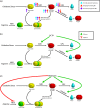Erythrocytes in multiple sclerosis - forgotten contributors to the pathophysiology?
- PMID: 28607726
- PMCID: PMC5433403
- DOI: 10.1177/2055217316649981
Erythrocytes in multiple sclerosis - forgotten contributors to the pathophysiology?
Abstract
Multiple sclerosis (MS) is an autoimmune disease characterised by lymphocytic infiltration of the central nervous system and subsequent destruction of myelin and axons. On the background of a genetic predisposition to autoimmunity, environmental triggers are assumed to initiate the disease. The majority of MS research has focused on the pathological involvement of lymphocytes and other immune cells, yet a paucity of attention has been given to erythrocytes, which may play an important role in MS pathology. The following review briefly summarises how erythrocytes may contribute to MS pathology through impaired antioxidant capacity and altered haemorheological features. The effect of disease-modifying therapies on erythrocytes is also reviewed. It may be important to further investigate erythrocytes in MS, as this could broaden the understanding of the pathological mechanisms of the disease, as well as potentially lead to the discovery of novel and innovative targets for future therapies.
Keywords: Erythrocytes; antioxidant enzymes; haemorheology; multiple sclerosis.
Figures

Similar articles
-
The Forgotten Brother: The Innate-like B1 Cell in Multiple Sclerosis.Biomedicines. 2022 Mar 4;10(3):606. doi: 10.3390/biomedicines10030606. Biomedicines. 2022. PMID: 35327408 Free PMC article. Review.
-
Insights into the aetiology and pathogenesis of multiple sclerosis.Immunol Cell Biol. 1998 Feb;76(1):47-54. doi: 10.1046/j.1440-1711.1998.00718.x. Immunol Cell Biol. 1998. PMID: 9553776 Review.
-
Autoimmune pathogenesis of multiple sclerosis: role of autoreactive T lymphocytes and new immunotherapeutic strategies.Crit Rev Immunol. 1997;17(1):33-75. doi: 10.1615/critrevimmunol.v17.i1.20. Crit Rev Immunol. 1997. PMID: 9034723 Review.
-
Neuronal injury in chronic CNS inflammation.Best Pract Res Clin Anaesthesiol. 2010 Dec;24(4):551-62. doi: 10.1016/j.bpa.2010.11.001. Epub 2010 Nov 29. Best Pract Res Clin Anaesthesiol. 2010. PMID: 21619866 Review.
-
Erythrocyte microRNA sequencing reveals differential expression in relapsing-remitting multiple sclerosis.BMC Med Genomics. 2018 May 21;11(1):48. doi: 10.1186/s12920-018-0365-7. BMC Med Genomics. 2018. PMID: 29783973 Free PMC article.
Cited by
-
Mood Symptoms and Chronic Fatigue Syndrome Due to Relapsing-Remitting Multiple Sclerosis Are Associated with Immune Activation and Aberrations in the Erythron.Brain Sci. 2023 Jul 14;13(7):1073. doi: 10.3390/brainsci13071073. Brain Sci. 2023. PMID: 37509005 Free PMC article.
-
Red blood cell metabolism: a window on systems health towards clinical metabolomics.Curr Opin Hematol. 2025 May 1;32(3):111-119. doi: 10.1097/MOH.0000000000000863. Epub 2025 Mar 13. Curr Opin Hematol. 2025. PMID: 40085132 Review.
-
Subcellular Mechanical Imaging of Erythrocytes with Optically Correlated Scanning Ion Conductance Microscopy.ACS Meas Sci Au. 2025 Apr 2;5(3):345-352. doi: 10.1021/acsmeasuresciau.5c00019. eCollection 2025 Jun 18. ACS Meas Sci Au. 2025. PMID: 40556881 Free PMC article.
-
Erythrocyte microRNAs show biomarker potential and implicate multiple sclerosis susceptibility genes.Clin Transl Med. 2020 Jan;10(1):74-90. doi: 10.1002/ctm2.22. Epub 2020 Apr 10. Clin Transl Med. 2020. PMID: 32508012 Free PMC article.
-
Red blood cells in type 1 diabetes and multiple sclerosis and technologies to measure their emerging roles.J Transl Autoimmun. 2022 Aug 7;5:100161. doi: 10.1016/j.jtauto.2022.100161. eCollection 2022. J Transl Autoimmun. 2022. PMID: 36039310 Free PMC article. Review.
References
-
- Compston A, Coles A. Multiple sclerosis. Lancet 2008; 372: 1502–1517. - PubMed
-
- Marieb EN, Hoehn K. Human anatomy & physiology, 9th Boston, MA: Pearson, 2013.
-
- Smith J. Exercise, training and red blood cell turnover. Sports Med 1995; 19: 9–31. - PubMed
-
- Ljubisavljevic S, Stojanovic I, Cvetkovic T, et al. Erythrocytes’ antioxidative capacity as a potential marker of oxidative stress intensity in neuroinflammation. J Neurol Sci 2014; 337: 8–13. - PubMed
Publication types
LinkOut - more resources
Full Text Sources
Other Literature Sources
Molecular Biology Databases

